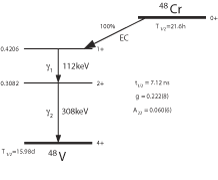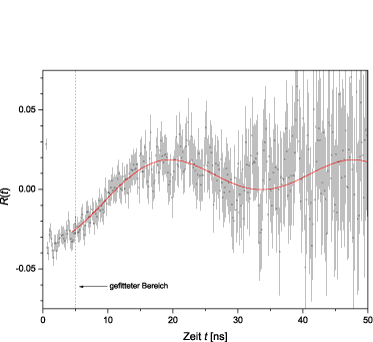
The decay of 48Cr to 48V with a half-life of t1/2 = 21.6 h populates a 112−308 keV γ-γ-cascade at almost 100% (Fig. 1). Due to the large enough anisotropy (A22 = −0.060(6)) and the not too short half-life t1/2 = 7.09(7) ns [1] of the 2+ intermediate state, the isotope is well suited for PAC studies. Yet, up to now, it has been rarely used for this purpose. The main reason seems to be the difficulty to produce enough activity to implant into any host lattice. Raether et al. [2] used the 46Ti(α, 2n)48Cr reaction in combination with the stacked-foil technique to implant 48Cr into iron samples and deduced the g-factor of the intermediate 2+ state g = 0.222(8). Because of the strong activation of the iron host an evaluation of the first 10 ns of the spectra was impossible leading to considerable difficulties in the evaluation of the data.
In the present experiments we used the natTi(3He, xn)48Cr reaction, which has several advantages. In particular it has the largest known production cross section σ = 8 mb for 48Cr [3]. Thus, it was possible to use a 5 μm thick natTi foil to produce sufficient amounts of 48Cr. The thin foil allowed the majority of probe nuclei to leave the production target. They were collected on two iron foils which were placed on both sides outside the primary beam.
For the production of a source with a total activity of 10 kBq we typically used a beam of 2 μA for about 70 h. The extremely efficient ECR ion source of the cyclotron allowed very moderate consumption of 3He during such a run. Recoil implanted iron foils were then annealed for 1 h at 500°C and then immediately used for the measurements. First results reproduce very well the data of Raether et al. [2] but show a much higher precision (Fig. 2).
 |
 |
[1] K. Auerbach, J. Braunsfurth, M. Maier, E. Bodenstedt, H.W. Flender; Nuclear Physics A94 (1967) 427–441
[2] F. Raether, K.P. Lieb; Hyperfine Interactions 34 (1987) 61–64
[3] R. Weinreich, H.J. Probst, S.M. Quaim; International Journal of Applied Radiations and Isotopes 31 (1980) 223–232